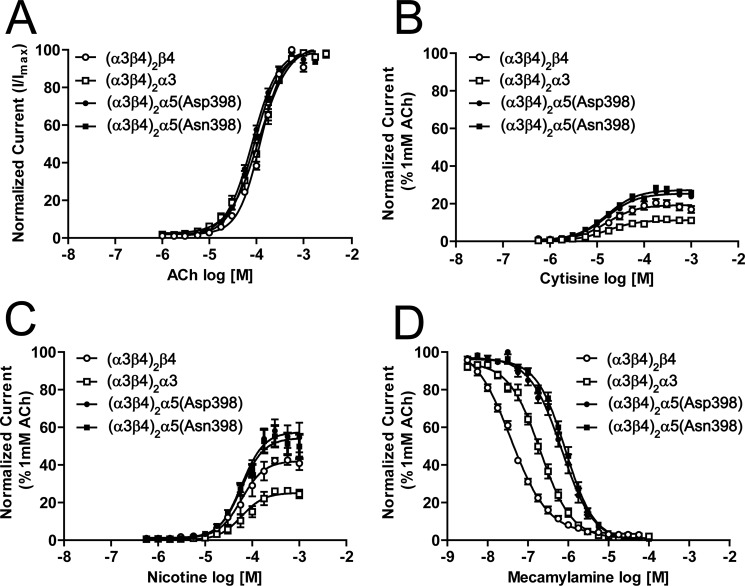FIGURE 3.
Positional effects and functional sensitivity of concatenated α3, β4, α5(Asp-398) and α5(Asn-398) nAChR subunits. Concentration response curves were generated for linked α3β4 nAChR containing β4 at position 5 (open circles), α3 at position 5 (open boxes), α5(Asp-398) variant at position 5 (filled circles), and α5(Asn-398) variant at position 5 (filled boxes). Concentration response curves were generated for known α3β4 nAChR agonists acetylcholine (α3β4)2(β4); n = 16; (α3β4)2(α3); n = 11; (α3β4)2α5(Asp-398); n = 17; (α3β4)2α5(Asn-398); n = 17) (A), cytisine (α3β4)2(β4); n = 6; (α3β4)2(α3); n = 6; (α3β4)2α5(Asp-398); n = 10; (α3β4)2α5(Asn-398); n = 10) (B), and nicotine (α3β4)2(β4); n = 6; (α3β4)2(α3); n = 6; (α3β4)2α5(Asp-398); n = 8; (α3β4)2α5(Asn-398); n = 8) (C). D, concentration response curves were also obtained using the α3β4 antagonist, mecamylamine (α3β4)2(β4); n = 6; (α3β4)2(α3); n = 6; (α3β4)2α5(Asp-398); n = 8; (α3β4)2α5(Asn-398); n = 8). Data points represent averages (±S.E.). For cytisine, nicotine, and mecamylamine, comparisons were made by normalizing current responses as % 1 mm ACh (see “Experimental Procedures”). Differences in drug potency and efficacy between groups were analyzed using one-way ANOVA with Tukey's post hoc comparison (see “Experimental Procedures”).

